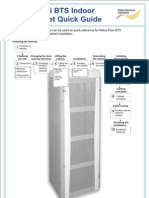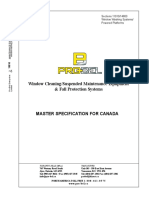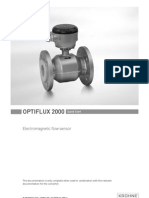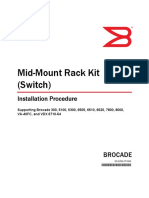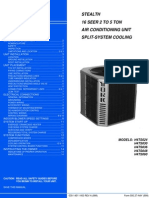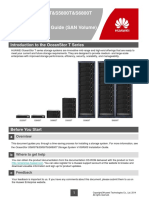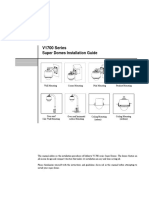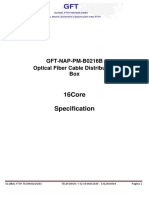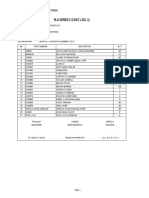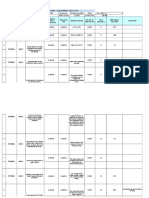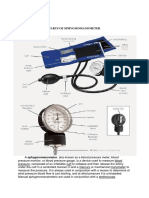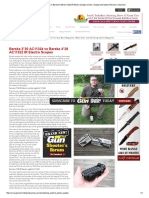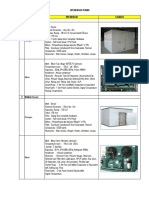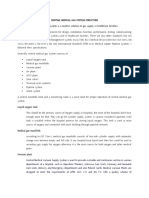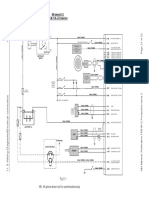Instalacion Flexi en Fcoa
Instalacion Flexi en Fcoa
Uploaded by
Vasco BrandãoCopyright:
Available Formats
Instalacion Flexi en Fcoa
Instalacion Flexi en Fcoa
Uploaded by
Vasco BrandãoCopyright
Available Formats
Share this document
Did you find this document useful?
Is this content inappropriate?
Copyright:
Available Formats
Instalacion Flexi en Fcoa
Instalacion Flexi en Fcoa
Uploaded by
Vasco BrandãoCopyright:
Available Formats
471449A 101 Nokia Flexi WCDMA Base Station, Rel. Flexi WBTS3.
2, Product Documentation
Installing Flexi Cabinet for Outdoor
DN7062824 Issue 2 en
# Nokia Corporation
1 (107)
Installing Flexi Cabinet for Outdoor
The information in this document is subject to change without notice and describes only the product defined in the introduction of this documentation. This document is intended for the use of Nokia's customers only for the purposes of the agreement under which the document is submitted, and no part of it may be reproduced or transmitted in any form or means without the prior written permission of Nokia. The document has been prepared to be used by professional and properly trained personnel, and the customer assumes full responsibility when using it. Nokia welcomes customer comments as part of the process of continuous development and improvement of the documentation. The information or statements given in this document concerning the suitability, capacity, or performance of the mentioned hardware or software products cannot be considered binding but shall be defined in the agreement made between Nokia and the customer. However, Nokia has made all reasonable efforts to ensure that the instructions contained in the document are adequate and free of material errors and omissions. Nokia will, if necessary, explain issues which may not be covered by the document. Nokia's liability for any errors in the document is limited to the documentary correction of errors. NOKIA WILL NOT BE RESPONSIBLE IN ANY EVENT FOR ERRORS IN THIS DOCUMENT OR FOR ANY DAMAGES, INCIDENTAL OR CONSEQUENTIAL (INCLUDING MONETARY LOSSES), that might arise from the use of this document or the information in it. This document and the product it describes are considered protected by copyright according to the applicable laws. NOKIA logo is a registered trademark of Nokia Corporation. Other product names mentioned in this document may be trademarks of their respective companies, and they are mentioned for identification purposes only. Copyright Nokia Corporation 2006. All rights reserved.
2 (107)
# Nokia Corporation
DN7062824 Issue 2 en
Contents
Contents
Contents 3 1 2 3 4 4.1 4.2 4.3 5 5.1 5.2 6 7 8 8.1 8.2 8.3 8.4 8.4.1 8.4.2 8.4.3 8.4.4 8.4.5 8.4.6 8.5 9 9.1 9.2 10 Overview of installing FCOA 5
Removing the FCOA cabinet roof 7 Lifting the FCOA 9 Installing the cabinet 13 Anchoring the FCOA 13 Changing the opening direction of the FCOA door Installing the FCOA security lock 31
17
Routing cabinet external cabling of FCOA 37 Routing the cables through FCOA cabinet bottom 37 Routing the cables through FCOA cabinet roof 39 Grounding the FCOA 43 Installing modules inside an outdoor cabinet 47 Installing options 53 Installing Flexi Power Module (FPMA) inside an outdoor cabinet Installing air filter 54 Installing Flexi System External Alarm (FSEA) 62 Installing battery backup solutions 66 Disassembling the rack 66 Installing batteries 68 Installing PDU and site support module 76 Installing the rectifier units (WPMB/WPMC) 94 Changing the alarm polarity of the WPUB unit 96 Changing the alarm polarity of the WPUC unit 100 Installing fire detector 102 Installation tools and torque values 105 FCOA installation tools and equipment 105 Torque values 106 Checklist for installing FCOA 107 53
DN7062824 Issue 2 en
# Nokia Corporation
3 (107)
Installing Flexi Cabinet for Outdoor
4 (107)
# Nokia Corporation
DN7062824 Issue 2 en
Overview of installing FCOA
Overview of installing FCOA
Purpose
This section describes the overview of the Nokia Flexi Cabinet for Outdoor (FCOA) installation process.
Steps
1. Check that the site meets the installation requirements. For further information, see Requirements for Installation and Operation. 2. 3. 4. 5. 6. 7. 8. 9. 10. 11. 12. 13. 14. Locate the site pack in the bottom right corner of the cabinet. Remove the cabinet roof. If required, lift the cabinet to the installation location. Anchor the cabinet on the base. Change the door opening direction, if needed. Install the security lock, if needed. Prepare the cabinet cable entries. Route the grounding cable and ground the cabinet. Install the optional air filter (FCFA). Install the Flexi System External Alarm (FSEA), if needed. Install the Flexi System External OVP (FSEC), if needed. Install the optional site support module (FCSA) and IBBU. Install the optional fire detector (FCDA).
DN7062824 Issue 2 en
# Nokia Corporation
5 (107)
Installing Flexi Cabinet for Outdoor
15.
Install the modules inside the cabinet.
16. 17. 18.
Route the cables in the cabinet and seal the cable entries. Install the roof. Connect the cables. For more information on cabling, see Cabling the BTS and Creating Configurations.
6 (107)
# Nokia Corporation
DN7062824 Issue 2 en
Removing the FCOA cabinet roof
Removing the FCOA cabinet roof
Purpose
The cabinet roof is removed for certain tasks, such as lifting the cabinet, routing the cabinet external cabling through the roof, installing the air filter, changing the door handedness, or installing the Flexi System External Alarm or Flexi System External OVP.
DN7062824 Issue 2 en
# Nokia Corporation
7 (107)
Installing Flexi Cabinet for Outdoor
Summary
Back
DN7068496
Figure 1.
Removing the cabinet roof
Steps
1. 2. 3. Open the door. Remove the screws behind the front plate. Remove the roof.
8 (107)
# Nokia Corporation
DN7062824 Issue 2 en
Lifting the FCOA
Lifting the FCOA
Purpose
Follow these instructions when the cabinet must be lifted to the desired installation location. An empty cabinet weighs max. 80 kg. It can be lifted by a sufficient number of personnel using the lifting handles (WLHA lifting handle LEKA Kit 469554A). Lifting eye bolts are not included in the delivery. They can be ordered separately (LEKA Kit 466289A). A fully equipped cabinet can be lifted with a crane.
DN7062824 Issue 2 en
# Nokia Corporation
9 (107)
Installing Flexi Cabinet for Outdoor
Handle
DN70119951
Figure 2.
Lifting handles
Before you start
Check that the cabinet roof is removed.
10 (107)
# Nokia Corporation
DN7062824 Issue 2 en
Lifting the FCOA
Summary
Lifting eye bolts (4 places)
Minimum 1500 mm (59.1 in)
DN7068215
Figure 3.
Lifting the cabinet
Warning
Follow the local safety regulations when lifting the cabinet.
Steps
1. 2. Attach the 4 x M12 lifting eye bolts to the attachment points. Attach the hoisting belt or rope to the lifting eye bolts.
DN7062824 Issue 2 en
# Nokia Corporation
11 (107)
Installing Flexi Cabinet for Outdoor
Make sure that the hoisting belt or rope loop is high enough to avoid bending the equipment.
Caution
A fully equipped cabinet weighs approximately 365 kg. Make sure that the hoisting belt or rope is sufficiently strong.
3. 4. 5. 6.
Lift the cabinet carefully to the desired installation height. Mount the cabinet. Remove the lifting equipment. Install the roof.
12 (107)
# Nokia Corporation
DN7062824 Issue 2 en
Installing the cabinet
4
4.1
Installing the cabinet
Anchoring the FCOA
Purpose
The cabinet must be anchored to the base if there is any risk of it toppling in areas with an earthquake risk, for example.
Before you start
The site is prepared and ready. When raining, some water may enter the cabinet through the door and back wall. It is important that the water can exit via the holes on the cabinet floor. If the cabinet is exposed to rain, it must be installed at least 20...50 mm off the ground by using, for example, an I-beam rail, metal grating or C-bars.
DN7062824 Issue 2 en
# Nokia Corporation
13 (107)
Installing Flexi Cabinet for Outdoor
Steel structure Cabinet fixing nut Cabinet spring washer
20-50 mm off the ground
DN70119909
DN7062824 Issue 2 en
Anchor bolt
Figure 4.
Anchoring the cabinet off the ground
14 (107)
# Nokia Corporation
Installing the cabinet
Summary
Cabinet fixing nut Cabinet spring washer Anchor bolt Concrete
DN7067649
Figure 5.
Anchoring the cabinet
Steps
1. Drill the anchoring bolt holes on the base. See the drilling template in the packing.
DN7062824 Issue 2 en
# Nokia Corporation
15 (107)
Installing Flexi Cabinet for Outdoor
with air filter cables routed via back with air filter and cables routed via side or bottom
1000 mm (39.3 in)
75 mm (3.0 in) 620 mm (24.4 in)
450 mm (17.7 in)
770mm (30.3 in)
fixing points
Front side
770mm (30.3 in)
DN70119963
Figure 6.
Anchoring bolt locations
2. 3. 4. 5.
Attach the anchoring bolts to the base. Position the cabinet on the anchoring bolts. Fix the nuts on the anchoring bolts. Check that the cabinet is level.
16 (107)
# Nokia Corporation
575 mm (22.6 in)
DN7062824 Issue 2 en
Installing the cabinet
6.
Tighten the nuts to 49 Nm.
4.2
Changing the opening direction of the FCOA door
Purpose
The door opening direction can be changed.
Steps
1. Detach the wind stopper from the door.
2 1
DN7073576
2. 3.
Detach the wind stopper from the cabinet and the cabinet. Detach the grounding cable from the door.
DN7062824 Issue 2 en
# Nokia Corporation
17 (107)
Installing Flexi Cabinet for Outdoor
Detail view inside the cabinet
ground cable
DN70119987
4.
Remove the hinge pins and detach the door.
18 (107)
# Nokia Corporation
DN7062824 Issue 2 en
Installing the cabinet
DN7073588
5.
Remove the hinge screws and hinges from the cabinet.
DN7062824 Issue 2 en
# Nokia Corporation
19 (107)
Installing Flexi Cabinet for Outdoor
5
Remove
DN7073591
6.
Remove the rubber plugs and install them on the other side of the cabinet.
20 (107)
# Nokia Corporation
DN7062824 Issue 2 en
Installing the cabinet
DN70148322
7.
Move the hinges to the new location in the cabinet.
DN7062824 Issue 2 en
# Nokia Corporation
21 (107)
Installing Flexi Cabinet for Outdoor
7 Screw
DN7073607
8.
Detach the locking rod guide plate.
22 (107)
# Nokia Corporation
DN7062824 Issue 2 en
Installing the cabinet
DN7073619
9.
Detach the door side plate (lock side).
DN7062824 Issue 2 en
# Nokia Corporation
23 (107)
Installing Flexi Cabinet for Outdoor
DN7073622
10.
Invert the door side plate 180 degrees (upside down).
24 (107)
# Nokia Corporation
DN7062824 Issue 2 en
Installing the cabinet
10
DN7073658
11.
Attach the door side plate back in its place. Fix with six screws. Tighten the two top screws first, then the two bottom ones, and last the two screws in the middle.
DN7062824 Issue 2 en
# Nokia Corporation
25 (107)
Installing Flexi Cabinet for Outdoor
11b
11a
11c
11b
DN70145637
12.
Thread the guide plate to the locking rod and attach it to the door.
26 (107)
# Nokia Corporation
DN7062824 Issue 2 en
Installing the cabinet
12
DN70145676
13.
Invert the door 180 degrees (upside down).
DN7062824 Issue 2 en
# Nokia Corporation
27 (107)
Installing Flexi Cabinet for Outdoor
13
DN70145652
14.
Install the door to the cabinet using the hinge pins. Push the hinge pins at least halfway down the hinge slots.
28 (107)
# Nokia Corporation
DN7062824 Issue 2 en
Installing the cabinet
14
DN7073673
15.
Thread the wind stopper to the guiding slot in the cabinet.
DN7062824 Issue 2 en
# Nokia Corporation
29 (107)
Installing Flexi Cabinet for Outdoor
15
DN70146893
16.
Attach the wind stopper to the door.
16
DN7073685
17.
Detach the grounding cable from the cabinet.
30 (107)
# Nokia Corporation
DN7062824 Issue 2 en
Installing the cabinet
19
18
ground cable
DN70120014
18. 19. 20.
Attach the grounding cable to the new location in the cabinet. Attach the grounding cable to the door. Move the magnetic proximity sensor magnet part from the bottom of the door to the top. a. Detach the two M3 screws. b. Invert the detached part 180 degrees. c. Move the magnet part to its new location and fix with the two M3 screws.
4.3
Installing the FCOA security lock
Purpose
An optional security lock can be installed on the cabinet door to prevent unauthorised personnel from accessing the cabinet. The lock installation is either a right-hand or left-hand installation depending on the handedness of the cabinet door.
DN7062824 Issue 2 en
# Nokia Corporation
31 (107)
Installing Flexi Cabinet for Outdoor
Summary
Unlocked
Right hand installation
Locked
Unlocked
Left hand installation
Locked
DN70148334
Figure 7.
Installing the security lock
Steps
1. Remove one of the rubber plugs.
32 (107)
# Nokia Corporation
DN7062824 Issue 2 en
Installing the cabinet
DN70148346
2. 3.
Remove the generic security lock latch from the lock. Take the Flexi BTS specific security lock latch from the site pack.
DN70148358
4.
Fit the security lock on the cabinet door.
DN7062824 Issue 2 en
# Nokia Corporation
33 (107)
Installing Flexi Cabinet for Outdoor
DN70148373
5.
Secure the security lock in its place with a nut.
DN70148397
6.
Attach the Flexi BTS specific security lock latch to the lock.
34 (107)
# Nokia Corporation
DN7062824 Issue 2 en
Installing the cabinet
DN70148416
7. 8. 9.
Secure the lock latch with a nut. Fix a rubber plug into the empty hole. Test the security lock. Test the lock by turning the key clockwise. Check that the latch moves correctly and that the door can be locked. In a left-hand installation, test the lock by turning the key clockwise and make sure that the latch is pointing upwards.
DN7062824 Issue 2 en
# Nokia Corporation
35 (107)
Installing Flexi Cabinet for Outdoor
36 (107)
# Nokia Corporation
DN7062824 Issue 2 en
Routing cabinet external cabling of FCOA
5
5.1
Routing cabinet external cabling of FCOA
Routing the cables through FCOA cabinet bottom
Purpose
The cabinet external cables can be routed in the cabinet through the cable entry on the cabinet bottom.
Caution
Optical cables are sensitive. When routing optical cables, do not exert stress on the optical fibres.
Summary
DN7062824 Issue 2 en
# Nokia Corporation
37 (107)
Installing Flexi Cabinet for Outdoor
2 1
power cables
cable ties
5 3 4
transmission cables cable routing supports
cable ties
antenna cables
DN7067785
Figure 8.
Routing the cables through cabinet bottom
38 (107)
# Nokia Corporation
DN7062824 Issue 2 en
Routing cabinet external cabling of FCOA
Steps
1. 2. 3. 4. Detach the two screws on the right. Remove the two cable gaskets from the cable entry. Connect the grounding cable. Route the power cables using cable clamps. Cable clamps and screws are included in the site pack. 5. Route the transmission cables through the cable entry and fix with cable ties. Install one of the cable gaskets, fixing cables to their places. Route antenna cables through the cable entry. Fix the cables with cable ties. Install the remaining cable gasket, fixing cables to their places.
6. 7.
8.
5.2
Routing the cables through FCOA cabinet roof
Purpose
The cabinet external cables can be routed in the cabinet through the cabinet roof.
Before you start
Remove the cabinet roof.
DN7062824 Issue 2 en
# Nokia Corporation
39 (107)
Installing Flexi Cabinet for Outdoor
Summary
Cable entries
2
power cables cable clambs cable ties
6 4 5
DN7068099
Figure 9.
Routing the cables through cabinet roof
40 (107)
# Nokia Corporation
DN7062824 Issue 2 en
Routing cabinet external cabling of FCOA
DN70100888
Figure 10.
Cable tie locations
Steps
1. Remove the cover plate from the lead-through you are going to use. There are three possible lead-throughs on top of the cabinet: one on each side, and one in the back. If you are using the lead-through in the back of the cabinet, first remove the rubber lead-ins on the inside of the cabinet to uncover the cable entry screws. 2. Place the lower half of the cable entry on the lead-through and fix with screws.
DN7062824 Issue 2 en
# Nokia Corporation
41 (107)
Installing Flexi Cabinet for Outdoor
3.
Route the cables in the cabinet. Power cables must be routed through cable clamps to reduce strain on the cables. Cable clamps and screws are included in the site pack.
4. 5. 6.
Fix the power cables with cable clamps. Fix the other cables with cable ties. Place the upper half of the cable entry on top of the lower one, fixing the cables to their places. Fix with screws.
42 (107)
# Nokia Corporation
DN7062824 Issue 2 en
Grounding the FCOA
Grounding the FCOA
Before you start
The grounding cable is not included in the delivery. It must be min. 16 mm2 (AWG 4).
DN7062824 Issue 2 en
# Nokia Corporation
43 (107)
Installing Flexi Cabinet for Outdoor
Summary
DN70100864
Figure 11.
Grounding points in FCOA
Steps
1. 2. 3. 4. Make sure the grounding cable is fixed to the site grounding point. Guide the cable through the cable entry. Strip approx. 2 cm (0.79 in.) of the main ground cable. Insert the stripped end of the cable into a cable shoe lug and crimp.
44 (107)
# Nokia Corporation
DN7062824 Issue 2 en
Grounding the FCOA
5.
Fit the lug to the grounding point in the cabinet and fix with a star washer and nut. Tighten to 3 Nm (for M5) or 5 Nm (for M8).
Tip
M8 is recommended for main grounding.
Further information
The modules are grounded to the cabinet rack, and no separate module grounding cables are required.
DN7062824 Issue 2 en
# Nokia Corporation
45 (107)
Installing Flexi Cabinet for Outdoor
46 (107)
# Nokia Corporation
DN7062824 Issue 2 en
Installing modules inside an outdoor cabinet
Installing modules inside an outdoor cabinet
Purpose
This section describes the module installation process inside an outdoor cabinet. The recommended installation location for the Flexi WCDMA BTS modules is the bottom of the cabinet. However, if you are going to use the site support module, reserve the bottom half of the cabinet for that purpose and install the modules starting from the top of the cabinet.
Before you start
.
If you are going to install cabinet options, such as the site support module, it is recommended that you do it before the module installation. Take the site pack from the bottom right corner of the cabinet.
Note
There are two air guide plates in the site pack. In Epsilon, when ESMA is in the vertical racks, the plate is fixed next to the ESMA (right-hand side) to guide air circulation and to provide a fixing point for cables.
Warning
When handling the modules, always use the antistatic wrist strap. The cabinet must be grounded, otherwise the antistatic wrist strap will not work.
DN7062824 Issue 2 en
# Nokia Corporation
47 (107)
Installing Flexi Cabinet for Outdoor
Note
Module cable entries are not used in cabinet installations.
Tip
Install the transmission sub-module to the System Module and connect the DC power cable before installing the System Module in the cabinet.
48 (107)
# Nokia Corporation
DN7062824 Issue 2 en
Installing modules inside an outdoor cabinet
Summary
1 3 3 5
8
DN7067688
Figure 12.
Installing modules inside an outdoor cabinet
Steps
1. 2. 3. Remove the fixing studs from the module casings. Remove the support plate behind the cage nuts. Remove the cable support plates from the casings.
DN7062824 Issue 2 en
# Nokia Corporation
49 (107)
Installing Flexi Cabinet for Outdoor
4. 5.
Detach the cage nuts from the module. Fix the guide plates (from the site pack). The cabinet has U markings printed on the fixing rail for 2 U and 3 U units. Check the markings and the sticker on the right-hand side to determine the starting place for module installation. There are 1 U markings on both sides of the racks. 1 U is 44.45 mm.
29U 27U 24U 21U 18U 15U 12U 9U 6U 1U 3U 1U 3U 6U
5U
DN7067734
Figure 13.
Placing shelves for WCDMA modules
50 (107)
# Nokia Corporation
DN7062824 Issue 2 en
Installing modules inside an outdoor cabinet
Tip
Use the dummy panels to determine the cage nut locations.
Tip
Fit the cage nuts so that the nut brackets point upwards and downwards instead of left and right.
6. 7. 8.
Fix the cage nuts (from the module) inside the cabinet. Slide the first module in. Fix the module to the cabinet with screws. Tighten to 5 Nm.
9. 10.
Repeat for each subsequent module. Install dummy panels into the empty slots.
DN7062824 Issue 2 en
# Nokia Corporation
51 (107)
Installing Flexi Cabinet for Outdoor
Expected outcome
Installation example, starting from the bottom
Site support installation
DN7067691
Figure 14.
Installation example, modules inside the cabinet
52 (107)
# Nokia Corporation
DN7062824 Issue 2 en
Installing options
8
8.1
Installing options
Installing Flexi Power Module (FPMA) inside an outdoor cabinet
Purpose
The Flexi WCDMA BTS uses 48 V DC power. In a BTS site with AC feed only, a Flexi Power Module (FPMA) or a site support module is required for converting the AC to DC before feeding the DC power to the System Module. The Flexi Power Module (FPMA) consists of mechanics, AC terminal and four slots for AC/DC sub-module (FPAA) or battery sub-module (FPBA). The FPMA can include:
.
two FPAAs and two FPBAs four FPAAs one FPAA and three FPBAs one FPAA and three free slots for expansion.
Steps
1. 2. 3. 4. 5. Remove the fixing studs for the module casing. Remove the support plate behind the cage nuts. Detach the cage nuts from the module. Remove the dummy panels. Fix the cage nuts (from the module) on the rack on the left-hand side of the cabinet.
DN7062824 Issue 2 en
# Nokia Corporation
53 (107)
Installing Flexi Cabinet for Outdoor
6. 7. 8.
Insert the module. Fix with screws. Insert dummy panels into the empty slots.
Further information
For FPAA and FPBA installation instructions, see section Installing Flexi Power Module (FPMA) in the Installing the Modules document. The sub-modules can be installed inside the FPMA before installing it into the cabinet.
8.2
Installing air filter
Purpose
The optional air filter can be used in case the environment is extremely dirty.
Before you start
Remove the cabinet roof.
Tip
It is recommended that the cabling be routed to the side or bottom when the air filter is used. If the cables are routed in the rear, antenna jumper cables must be disconnected.
Summary
54 (107)
# Nokia Corporation
DN7062824 Issue 2 en
Installing options
ambient pressure hose pressure sensor
cabinet pressure hose to + terminal
to control box
DN70121119
Figure 15.
Air filter power supply cable (left-hand installation)
Steps
1. Remove the 4 x M5 screws inside the cabinet.
DN7062824 Issue 2 en
# Nokia Corporation
55 (107)
Installing Flexi Cabinet for Outdoor
back side
1
M5 4 pcs
DN70150241
2.
Remove the cabinet back plate. Lift the back plate first upwards and then outwards.
3.
Remove the two bars behind the cabinet. Loosen the 4 x M5 screws from both sides and detach the bars.
56 (107)
# Nokia Corporation
DN7062824 Issue 2 en
Installing options
DN70150253
4.
Remove the air filter roof.
DN7062824 Issue 2 en
# Nokia Corporation
57 (107)
Installing Flexi Cabinet for Outdoor
DN70150265
5.
Fix the air filter in place with the guide pins (one at the top and one at the bottom of the air filter).
58 (107)
# Nokia Corporation
DN7062824 Issue 2 en
Installing options
M5 15 pcs 7
5 6
DN70150277
6.
Fix the air filter on the cabinet with 22 x M5 screws at the back and 4 x M5 on the roof.
Tip
Use the screws from the detached bars in the previous step. In addition, use additional screws included in the air filter site pack.
7. 8.
Connect the alarm cable to the FSEA box. Route the air filter fan power cable through a vacant bushing seal and connect it to the screw terminal on the control box printed circuit board. There are two alternatives. Either: a. Connect the power cable (995083) from the FPFA. Or:
DN7062824 Issue 2 en
# Nokia Corporation
59 (107)
Installing Flexi Cabinet for Outdoor
b.
Attach the fuse into the FSEA box DIN rail and connect the power cable (995084).
9.
Connect the air filter power cables to the FSEA box. Make sure that the polarity is correct: black +, blue -.
10.
Route the ambient pressure hose to the cabinet door.
DN70121119 DN70150289
11.
Install the back cover.
60 (107)
# Nokia Corporation
DN7062824 Issue 2 en
Installing options
13
15
12
DN70150432
12. 13. 14. 15.
Install the air filter roof. Install the cable entry, if necessary. Install the cabinet roof. Install the wind blocking plate on the cabinet door, if necessary.
DN7062824 Issue 2 en
# Nokia Corporation
61 (107)
Installing Flexi Cabinet for Outdoor
16a
16c 16d
16b
DN70154764
a. b. c. d.
Fix four screws and washers on the cabinet door. Install the wind blocking plate. Tighten the screws. Fix the rubber plugs in the wind blocking plate.
8.3
Installing Flexi System External Alarm (FSEA)
Purpose
The Flexi System External Alarm (FSEA) is used as an external alarm module. The box provides IP55 protected screw terminals (12 for alarm inputs and 6 for control outputs) and power for the Flexi Cabinet Fire Detector (FCDA).
62 (107)
# Nokia Corporation
DN7062824 Issue 2 en
Installing options
Before you start
The system external alarm connection box can be installed on a pole or wall. Locate the box in the proximity of the System Module. In wall installations, make sure that the mounting surface is flat. The box can also be installed on the roof of an outdoor cabinet. In cabinet installations, use the fixing points on the cabinet roof.
Caution
Electrostatic discharge (ESD) may damage the equipment. Wear an ESD wrist strap when handling the external alarm connection box.
Note
Make sure that jumper X1103 is set to WCDMA.
Tip
When connecting the cables, make sure that the cable lead-ins that are not used are blocked.
Steps
1. Install the box with 4 x M5 screws using the fixing holes in the bottom of the box. The box can be installed either horizontally (cable lead-ins on the side) or vertically (cable lead-ins facing downwards). In outdoor installations, the cable lead-ins must be facing downwards to meet the IP55 standard. 2. 3. In wall or pole installations, fix the box and cables to the wall or pole. Connect the grounding cable to the grounding screw on the right side of the FSEA front plate. Screw the nut tightly. 4. Connect the ESD wrist strap first to your wrist and then to the grounding clip next to the grounding screw.
DN7062824 Issue 2 en
# Nokia Corporation
63 (107)
Installing Flexi Cabinet for Outdoor
5.
Connect the external alarms cable (included in the FSEA delivery) from the FSEA to the System Module. a. Pull the left U-shaped cable gland from the FSEA box. b. Remove the hole closing plug from the cable gland. If the plug is fixed with a cable tie, cut the cable tie first and remove it. c. Insert the cable in the cable gland. The D-Sub plug must point to the inside of the box. d. Connect the D-Sub plug to the leftmost D-Sub connector X1101 on the FSEA board. e. Fix the connector fixing screws. f. Insert the U-shaped cable gland to the front plate. g. Fix the cable with a cable tie. Make sure that the U-gland fixes the cable tightly. h. Remove the cover of the EAC connector on the System Module. i. Insert the other end of the cable with the MDR-36 connector to the EAC connector of the System Module. Make sure that the MDR connector is firmly in place. j. Push the connector cover over the MDR connector and seal the EAC connector at the System Module with this cover. k. Route the cable between the FSEA and System Module and fix it with cable ties. The first fixing point must not be further away from the FSEA box than 0.5 m. Connect the combined alarm cable with a D-Sub connector.
6.
Tip
When upgrading to the Flexi WCDMA BTS, there might be a pre-installed alarm cable with a 37-pole D-Sub connector attached. This cable can be attached to the EACX-I connector of the FSEA. a. b. c. d. e. f. g. Pull the right U-shaped cable gland from the FSEA box. Cut the cable tie off the cable gland. Remove the hole closing plug from the cable gland. Insert the alarm cable in the cable gland. The D-Sub plug must point to the inside of the box. Attach the D-Sub plug to the right 37-pole D-Sub connector X4101 (EACX-I port). Fix the connector fixing screws. Insert the U-shape cable gland to the front plate.
64 (107)
# Nokia Corporation
DN7062824 Issue 2 en
Installing options
h. i.
Fix the cable with a cable tie. Make sure that the U-gland fixes the cable tightly. Route the cable and fix it with cable ties. The first fixing point must not be further away from the FSEA box than 0.5 m.
7.
Connect the single alarm cables to the screw terminals. a. Insert the alarm cables in the FSEA box by using the cable glands on the right-side half of the FSEA box. b. Tighten the cable gland nut. c. Route the alarm cables and fix them with cable ties. The first fixing point must not be further away from the FSEA box than 0.5 m. d. Attach alarm lines EXT_AL0 to EXT_AL11 using screw terminal blocks X4106-X4109. e. For each alarm input connect one wire to the GROUND screw terminal blocks X4107 or X4109 and connect one wire to the selected alarm input on screw terminal blocks X4106 or X4108. The alarm inputs are marked on the FSEA board with "EXT_AL5 ... EXT_AL0" on X4106 and "EXT_AL11 ... EXT_AL6" on X4108.
Note
If you use alarm inputs on the EACX-I port (D-Sub connector X4101), do not use the same alarm inputs on the screw terminals X4106 and X4108.
8.
Connect the control output cables. a. Insert the control output cables in the FSEA box by using the cable glands on the right-side half of the box. b. Tighten the cable gland nut. c. Route the control cables and fix them with cable ties. The first fixing point must not be further away from the FSEA box than 0.5 m. d. Attach the control lines EXT_CO0 to EXT_CO5 by using the screw terminal blocks X4104 and X4105. e. For each control output connect one wire to the +5V screw terminal block X4105 and one wire to the selected control output on screw terminal X4104. The control outputs are marked on the FSEA board with "EXT_CO5 ... EXT_CO0" on X4104.
Note
If you use control outputs on the EACX-I port (D-Sub connector X4101), do not use the same control outputs on the screw terminal X4104.
DN7062824 Issue 2 en
# Nokia Corporation
65 (107)
Installing Flexi Cabinet for Outdoor
9.
Install the fire detector to the FSEA (optional). a. Connect the fire detector to the FSEA using a four-wire cable. Two wires are needed for fire detector power supply and two for the fire detector alarm connection. b. Attach the four wires of the cable to the fire detector relay-base. c. Insert the other end of the four wire cable through one cable gland at the right half of the FSEA box. d. Tighten the cable gland nut. e. Route the alarm cables and fix them with cable ties. The first fixing point must not be further away from the FSEA box than 0.5 m. f. Attach the wire marked with + from the fire detector to the leftmost or rightmost opening of the screw terminal X4114. g. Attach the wire marked with - from the fire detector to one of the four middle openings of the screw terminal X4114 marked with GND. h. Attach the fire detector alarm wires to one of the alarm inputs "EXT_AL11 ... EXT_AL0". Close the cover of the FSEA box. Tighten the six screws.
10.
8.4
8.4.1
Installing battery backup solutions
Disassembling the rack
Purpose
Before installing the site support, the lower part of the cabinet rack must be disassembled.
66 (107)
# Nokia Corporation
DN7062824 Issue 2 en
Installing options
Summary
DN7067773
Figure 16.
Disassembling the rack
Steps
1. Remove the screws (8 pcs). See figure Disassembling the rack for a detailed screw location.
Tip
Save the screws for later use.
2.
Disassemble the two lower shelves and the vertical wall.
DN7062824 Issue 2 en
# Nokia Corporation
67 (107)
Installing Flexi Cabinet for Outdoor
Further information
Proceed to the Installing batteries section.
8.4.2
Installing batteries
Before you start
.
Install the PDU unit in the site support module. Disassemble the rack as instructed in the Disassembling the rack section. Make sure that the outdoor cabinet is grounded to the site main ground.
Summary
Battery back fixing plate
DN70148685
Figure 17.
Principle of installing batteries
68 (107)
# Nokia Corporation
DN7062824 Issue 2 en
Installing options
Steps
1. Install the mounting part to the left.
DN7073704
2.
Fix with two screws on the wall and two screws on the floor.
DN7073716
3. 4.
Remove the floor plate. Install the air guide plate between the left mounting rack and the cabinet rack with two screws.
DN7062824 Issue 2 en
# Nokia Corporation
69 (107)
Installing Flexi Cabinet for Outdoor
DN70121049
5.
Install the battery back fixing plate. There are two possible installation locations depending on the size of the batteries. . If you are using 92 Ah batteries, proceed as instructed in these instructions. . If you are using 62 Ah batteries, remove the rail from the battery back fixing plate first.
6.
Fix with three screws.
70 (107)
# Nokia Corporation
DN7062824 Issue 2 en
Installing options
left side
right side
6 5 6
Rail
DN70119842
Figure 18.
92 Ah batteries
left side
right side
6 5
DN7073728
Figure 19.
62 Ah batteries
7.
Move the battery support on the left to the location required by the size of the batteries.
DN7062824 Issue 2 en
# Nokia Corporation
71 (107)
Installing Flexi Cabinet for Outdoor
battery supports
DN7073731
Figure 20.
Locating the battery supports
72 (107)
# Nokia Corporation
DN7062824 Issue 2 en
Installing options
92 Ah
62 Ah
rail space for batteries space for batteries
DN70135374
Figure 21.
Principle of locating the battery supports
8.
Install the mounting rail to the right. Fix with two screws. See the following figure for a detailed location.
DN7062824 Issue 2 en
# Nokia Corporation
73 (107)
Installing Flexi Cabinet for Outdoor
6U
DN7073743
9.
Install the batteries. Use an isolated wrench.
74 (107)
# Nokia Corporation
DN7062824 Issue 2 en
Installing options
left side
right side
cage nuts
9a
9a
9b
9e
9c 9f
9d
9f 9g
anderson cable
DN7068121
a. b. c.
Fix 4 x cage nuts to the cabinet. Place the batteries in the cabinet, starting from either left or right. Fix with the battery front plate.
DN7062824 Issue 2 en
# Nokia Corporation
75 (107)
Installing Flexi Cabinet for Outdoor
d. e. f.
g.
If you are using 62 Ah batteries, remove the rail behind the battery front plate. Connect the batteries in series and tighten the bolt. Install the battery terminal covers. Connect the Anderson cable (994955) to the batteries and tighten to 5 Nm. Make sure you install the rubber boots. Fix the battery cable connector to the battery front plate with cable ties.
8.4.3
Installing PDU and site support module
Purpose
The optional site support module (FCSA) can be used with the outdoor cabinet to provide long-term battery back-up time for the Flexi WCDMA BTS, and a space for installing LTE units. The PDU (Power Distribution Unit, WPUB or WPUC) is utilised when a site support module is used. The PDU converts the AC power into DC power, which the base station uses. The FCSA control card collects and converts alarms information from the fans, LTE units and MIBBU. The alarms are connected to EAC lines, which is done with the use of dip switches on the board. The default settings are presented in the following table. If necessary, the routing of alarms can be changed by adjusting the dip switches.
Table 1. Pin
1 2 3 4 5
External alarms pin assignment Signal
INT_FAN_ALARM EXT_FAN_ALARM TEMP_ALARM LTE_POWER_ALA RM EXT_ALARM1 (default not connected) EXT_ALARM2 (default not connected) MAINS#1 MAINS#2
Pin
9 10 11 12 13
Signal
MAINS#3 ALARM_GND ALARM_GND ALARM_GND ALARM_GND
14
ALARM_GND
7 8
15
ALARM_GND
76 (107)
# Nokia Corporation
DN7062824 Issue 2 en
Installing options
+48 V Out Fuse max 3.15 A +48 V Out Fuse max 3.15 A Status Status Ext Alarms Output MIBBU Alarms Input Int fan1 +48 V Out Fuse max 10 A
Int fan2 Ext fan1
Ext fan2
+48 V Out Fuse max 3.15 A +48 V Out Fuse max 3.15 A
DN70164318
Figure 22.
FCSA control card
DN7062824 Issue 2 en
# Nokia Corporation
77 (107)
Installing Flexi Cabinet for Outdoor
Before you start
.
Open the site support module and take out the installation parts. Check that the alarm polarity is correct. The default setting for the alarm polarity is Normally Open. If you need to change it, see Changing the alarm polarity for the WPUB unit or Changing the alarm polarity for the WPUC unit, depending on your base station setup. Remember also to change the Intelligent Shutdown polarity, if using it.
Steps
1. Fix the external fans on the site support module (FCSA).
DN70154873
2. 3.
Remove covers from the bushing seals you are going to use. Place the FCSA module on its back. Take care not to damage the guide pins on the module.
78 (107)
# Nokia Corporation
DN7062824 Issue 2 en
Installing options
4.
Remove the plastic cover from the rear of the PDU. The plastic cover shields the connectors from above. It needs to be removed before the cables can be attached to the PDU.
Caution
Risk of short circuit. Make sure that all the breakers on the power distribution unit (PDU) front panel are in the OFF position before you connect the cables.
4 5
DN70155245
5. 6.
Uninstall the FCSA control card. Connect the cable (994953) behind the control card and reinstall the control card.
DN7062824 Issue 2 en
# Nokia Corporation
79 (107)
Installing Flexi Cabinet for Outdoor
6b
6a
DN70155221
7.
Connect the control card power feeding cable to the PDU.
80 (107)
# Nokia Corporation
DN7062824 Issue 2 en
Installing options
7 7
DN7062824 Issue 2 en
BTS
-
- +
Common+ Battery -
+ DN70155233
# Nokia Corporation 81 (107)
Installing Flexi Cabinet for Outdoor
DN0550465
Figure 23.
Principle of connecting the control card power feeding cable to PDU
In case the MIBBU is not used, power for the control card for FCSA is taken from the power terminals on the cabinet roof. 8. Route the battery cables through the cable entries in the back of the site support module. Make sure the rubber parts remain in place when routing the cables. Do not tighten the bushing seals at this point.
82 (107)
# Nokia Corporation
DN7062824 Issue 2 en
Installing options
DN7062824 Issue 2 en
BTS
-
- +
Common+ Battery -
8
-
DN70155257
9.
Attach the DC cables to the rear of the PDU.
# Nokia Corporation
83 (107)
Installing Flexi Cabinet for Outdoor
10
84 (107)
BTS
-
- +
Common+ Battery -
+ -
DN70155269
# Nokia Corporation
DN7062824 Issue 2 en
Installing options
Top view WPUB cabling
BTS + Control card + Battery +
BTS Control card -
Connect the cables
- +
Battery -
Remove the plastic cover
BTS -
Battery - Common+
DN7068106
Figure 24.
Connecting DC cables to PDU (WPUB)
Top view WPUC cabling
BTS + Control card +
BTS Control card -
Connect the cables
Battery +
Battery -
Remove the plastic cover
45 degrees or less
BTS -
Battery -
Common +
Remove the plastic cover
DN70120077
Figure 25.
Connecting DC cables to PDU (WPUC)
10.
Reinstall the plastic cover on the PDU.
DN7062824 Issue 2 en
# Nokia Corporation
85 (107)
Installing Flexi Cabinet for Outdoor
11.
Route the AC cable through the cable entry in the rear of the FCSA.
11
DN70155272
12.
Connect the AC cable to the AC terminal plate. See the following figures for AC cable connections.
86 (107)
# Nokia Corporation
DN7062824 Issue 2 en
Installing options
Single Phase connection
N1
L1 L2 L3
AC Power input cable Cable routing support
PE
N2 N3
Bridges
1~ Connection N N1 N2 N3 PE L1 L2 L3 L
PE
L1/L2/L3= Phase N= Neutral, PE= Protective earth
DN02165007
Figure 26.
Single phase, 230 V AC
DN7062824 Issue 2 en
# Nokia Corporation
87 (107)
Installing Flexi Cabinet for Outdoor
3-phase delta connection
N1
L1 L2 L3
AC Power input cable Cable routing support
PE
N2 N3
3~ Connection N1 N2 N3 PE L1 L2 L3 PE L1 L2 L3
L1/L2/L3= Phase N= Neutral, PE= Protective earth
DN02178657
Figure 27.
3-phase (delta), base voltage 100-120 V AC
88 (107)
# Nokia Corporation
DN7062824 Issue 2 en
Installing options
3-phase star connection
N1
L1 L2 L3
AC Power input cable Cable routing support
PE
N2 N3
Bridge
3~Y Connection N N1 N2 N3 PE L1 L2 L3 PE L1 L2 L3
L1/L2/L3= Phase N= Neutral, PE= Protective earth
DN02178645
Figure 28.
3-phase (star), 230 V AC
13.
Install the AC terminal plate on the FCSA. The AC interface comes attached to the PDU with a sleeve. Install the AC terminal plate inside the brackets in the site support module: a. Slide the rear edge of the AC interface in the bracket slots. b. Fix the front edge on the bracket with two screws.
DN7062824 Issue 2 en
# Nokia Corporation
89 (107)
Installing Flexi Cabinet for Outdoor
12 13
DN70155284
14.
If you are using the WPUB unit Then
connect the thermal sensor cable to the back of the PDU.
15.
Install the PDU. Slide the PDU unit inside the site support module. Fix with four screws.
90 (107)
# Nokia Corporation
DN7062824 Issue 2 en
Installing options
15 16
DN70155518
16.
Tighten the bushing seals. . PG13.5 to 2.5 Nm . PG21 and PG29 to 5 Nm
17.
If you are using the WPUC unit Then
connect the battery thermal sensor cable to the front panel of the PDU.
18.
Align the site support module (with the PDU unit) with the guiding pins in the back of the cabinet. Install the site support module.
DN7062824 Issue 2 en
# Nokia Corporation
91 (107)
Installing Flexi Cabinet for Outdoor
18
DN70155296
19.
Fix the site support module to the cabinet with two screws.
19
DN70119878
20.
Route the thermal sensor cable and push the rubber plug in place.
92 (107)
# Nokia Corporation
DN7062824 Issue 2 en
Installing options
21.
Connect the site support fan cables to the Int fan and Ext fan connectors on the FCSA control card. Route the cables through the site support module cable entries. Push the rubber plug through the cable entry to seal the entry point. Fix the fan cables to the cabinet with cable ties.
22.
Connect the alarm cable from the Ext Alarms Output connector on the FCSA control card to the external alarms connector located in the FSEA box (if used) on the cabinet roof. Route the alarm cable through the cable entries on the side of the site support module sloping downwards. Once the cable is outside the site support module, make a loop and route the cable to the cabinet roof.
22
DN70121652
DN7062824 Issue 2 en
# Nokia Corporation
93 (107)
Installing Flexi Cabinet for Outdoor
23.
Connect the alarm cable from the EAC connector on the PDU to the MIBBU Alarms Input connector on the FCSA control card. Fix with cable ties. There are three alarm lines from the MIBBU unit routed via the control card to the FSEA. If additional alarms from the MIBBU are needed, a separate cable between the MIBBU and FSEA is required.
24.
Connect the battery cable connector from the PDU to the battery cable connector from the batteries.
DN70100525
8.4.4
Installing the rectifier units (WPMB/WPMC)
Purpose
The PDU provides four slots for the rectifiers. Each of the PDU versions (WPUB/ WPUC) has its own rectifier unit: WPMB/WPMC. Install the rectifier units as described in these instructions.
Before you start
Remove the dummy panels from the PDU.
94 (107)
# Nokia Corporation
DN7062824 Issue 2 en
Installing options
Steps
1. Install the rectifier units. Install the rectifier units in their places. Note that if the rectifier is the type that has the retaining hooks (WPMB), the hooks must be in an open position before fixing the unit in place. Use a small screwdriver in the holes in the upper left- and right-hand corners of the unit to release the hooks.
Retaining hooks
Fixing screw
DN0424983
Figure 29.
Installing the rectifiers, WPMB (top) and WPMC (bottom)
2.
Secure the units.
DN7062824 Issue 2 en
# Nokia Corporation
95 (107)
Installing Flexi Cabinet for Outdoor
When the unit is in place, tighten the knurled-head fixing screw or insert the retaining hooks in their slots, depending on the unit type used.
Note
The retaining hooks are fragile. Do not carry the unit by the retaining hooks.
3.
Switch on the breakers on the PDU front panel. Turn the breakers on the PDU front panel into the ON position.
Note
Do not switch on the breakers before the BTS installation is completed.
4.
Close the lid.
8.4.5
Changing the alarm polarity of the WPUB unit
Before you start
The EAC alarm polarity can be set to two states, Normally Open or Normally Closed. The Normally Open state means that the galvanic EAC alarm circuit loop is open and electric current is not flowing through it. The corresponding EAC alarm is activated if the EAC alarm circuit loop is closed. The Normally Closed state means that the galvanic EAC alarm circuit loop is closed and electric current is flowing through it. The corresponding EAC alarm is activated if the EAC alarm circuit loop is opened. The default alarm polarity is Normally Closed.
Note
Ensure that you set the EAC alarm polarity correspondingly during BTS commissioning.
96 (107)
# Nokia Corporation
DN7062824 Issue 2 en
Installing options
Steps
1. To change the polarity for alarm relay output from the Normally Open state to the Normally Closed state, connect the wires according to the following table and figure Changing the alarm polarity of the WPUB unit, option B.
Table 2. Pin no.
19 20 21 22 23 24 25 26 27 28 29 30 31 32 33 34 35 36
CON 5 Relays for the Normally Closed state Name
REL6 NC REL6 NO REL6 COM REL5 NC REL5 NO REL5 COM REL4 NC REL4 NO REL4 COM REL3 NC REL3 NO REL3 COM REL2 NC REL2 NO REL2 COM REL1 NC REL1 NO REL1 COM
Connect to
Not in use D-sub female pin 6 Link to pin 36 on this connector Not in use D-sub male pin 5 Link to pin 36 on this connector Not in use D-sub male pin 4 Link to pin 36 on this connector Not in use D-sub male pin 3 Link to pin 36 on this connector Not in use D-sub male pin 2 Link to pin 36 on this connector Not in use D-sub male pin 1 Common + link to above
DN7062824 Issue 2 en
# Nokia Corporation
97 (107)
Installing Flexi Cabinet for Outdoor
Note
If necessary, use a screwdriver to remove the CON5 connector from the WPUB before changing the polarity. Reinstall the CON5 connector after the polarity has been changed.
Rear view of interface card/system A) Relays for Normally Closed
Pin 19 11 12 13 14 15 16 17 18 19 20 1 2 3 4 5 6 7 8 9 10 CON 4
Pin 36
19 20 21 22 23 24 25 26 27 28 29 30 31 32 33 34 35 36 1 2 3 4 5 6 7 8 9 10 11 12 13 14 15 16 17 18 CON 5
B) Relays for Normally Open (default polarity)
Pin 19 11 12 13 14 15 16 17 18 19 20 1 2 3 4 5 6 7 8 9 10 CON 4
Pin 36 19 20 21 22 23 24 25 26 27 28 29 30 31 32 33 34 35 36 1 2 3 4 5 6 7 8 9 10 11 12 13 14 15 16 17 18 CON 5 DN0570827
Figure 30.
Changing the alarm polarity of the WPUB unit
98 (107)
# Nokia Corporation
DN7062824 Issue 2 en
Installing options
2.
To change the polarity for alarm relay output back from the Normally Closed state to the Normally Open state, connect the wires according to the following table and figure Changing the alarm polarity of the WPUB unit, option A.
Table 3. Pin no.
19 20 21 22 23 24 25 26 27 28 29 30 31 32 33 34 35 36
CON 5 relays for the Normally Open state Name
REL6 NC REL6 NO REL6 COM REL5 NC REL5 NO REL5 COM REL4 NC REL4 NO REL4 COM REL3 NC REL3 NO REL3 COM REL2 NC REL2 NO REL2 COM REL1 NC REL1 NO REL1 COM
Connect to
D-sub male pin 6 Not in use Link to pin 36 on this connector D-sub male pin 5 Not in use Link to pin 36 on this connector D-sub male pin 4 Not in use Link to pin 36 on this connector D-sub male pin 3 Not in use Link to pin 36 on this connector D-sub male pin 2 Not in use Link to pin 36 on this connector D-sub male pin 1 Not in use D-sub male pin 9 + link to above
Note
If necessary, use a screwdriver to remove the CON5 connector from the WPUB before changing the polarity. Reinstall the CON5 connector after the polarity has been changed.
DN7062824 Issue 2 en
# Nokia Corporation
99 (107)
Installing Flexi Cabinet for Outdoor
8.4.6
Changing the alarm polarity of the WPUC unit
Before you start
There are eight galvanic isolated alarm contacts for remote supervision of the alarms. Each alarm contact represents different alarm conditions. Alarm relay coils are powered during normal operation. All alarm relays will give an alarm with no AC or DC power connected to the system.
Alarms EAC
1 6
2 7
3 8
4 9
Alarm 1: Pin 1 Alarm 2: Pin 2 Alarm 3: Pin 3 Alarm 4: Pin 4 Alarm 5: Pin 5 Alarm 6: Pin 6 Alarm 7: Pin 7 Alarm 8: Pin 8 Common: Pin 9
DN0570839
Figure 31.
Alarm connection, 9-pin D-sub
Note
While it is recommended to change the polarity before installing the unit into the cabinet, with the WPUC unit it is also possible to do this later.
100 (107)
# Nokia Corporation
DN7062824 Issue 2 en
Installing options
Note
Always use the antistatic wrist strap when handling the WPUC.
Steps
1. Loosen the fixing screw and pull out the alarm interface unit using the handle. Use JP8 for setting the alarm relays to closed on alarm or open on alarm. The jumper mounted between pins 1 and 2 on the jumpers (default) means closed on alarm for the corresponding relay. The jumper mounted between pins 2 and 3 on the jumpers means open on alarm for the corresponding relay. The jumper numbers correspond to the relay numbering (for instance, JP5 to RL5).
2.
Note
When the jumpers are mounted between pins 1 and 2, the alarm polarity is Normally Open. When the jumpers are mounted between pins 2 and 3, the alarm polarity is Normally Closed.
DN7062824 Issue 2 en
# Nokia Corporation
101 (107)
Installing Flexi Cabinet for Outdoor
R64 R62 R60 R63 R61 R90 R82 R84 R85 R37 Q5 D3 RL12 RL11
JP3 JP2
R21
P2 P3
R29
JP4
1 R26 D1 D4
1
Jumper settings
1 JP12 1 JP10 1 JP8 1
RL10
J12
RL9
JP11 Alarms EAC 1 JP9
RL8 C21 Q6 R30
C24
RL7
1 JP7
RL6
RL5
1 JP5
JP6
J1 SC6 DN0570842
Figure 32.
Alarm interface unit from above
3.
Reinstall the alarm interface unit.
8.5
Installing fire detector
Before you start
Check that the cabinet roof has been removed. Remove the plastic cover from the fire detector before installing it. When using the fire detector, the FSEA box is needed.
102 (107)
# Nokia Corporation
DN7062824 Issue 2 en
Installing options
Summary
Back side
2 3 3 1
DN7068133
Figure 33.
Installing fire detector
Steps
1. 2. 3. Strip the fire detector cable as needed. Make the power and alarm connections. Slide the notches in the fire detector back plate in the slots on the cabinet roof. Turn the fire detector in an upright position. Fix with one M5 screw.
4. 5.
DN7062824 Issue 2 en
# Nokia Corporation
103 (107)
Installing Flexi Cabinet for Outdoor
6.
Fix the cable with cable ties.
104 (107)
# Nokia Corporation
DN7062824 Issue 2 en
Installation tools and torque values
9
9.1
Installation tools and torque values
FCOA installation tools and equipment
This section lists the installation tools and equipment.
Table 4.
Tools for installation
Installation tools
Allen key: 5 mm (0.20 in.) ESD wrist strap and cable TORX screwdriver set: T10, T20, T25 Screwdriver slotted for power input connections Wrench 13 mm (0.51 in.) Folding knife Monkey wrench Side cutters Torque wrench for antenna cables: Open spanner end with bended shank 32mm@25 Nm (DIN 7-16 connector) Socket or open ended spanner set: 11 mm (0.43 in.), 13 mm (0.51 in.), 17 mm (0.67 in.), 18 mm (0.71 in.) Open ended spanner 22 mm or tongs Lint-free swab or wipe and 99% alcohol for cleaning optical connectors Cable ties for routing cables Tape measure Flashlight, pocket lamp or torch Hammer drill Marker pen or comparable tool Pliers
DN7062824 Issue 2 en
# Nokia Corporation
105 (107)
Installing Flexi Cabinet for Outdoor
9.2
Torque values
Nokia strongly recommends that you tighten to the following torque values. These values assume the use of a lubricated bolt or fastener. Use these values unless stated otherwise.
Table 5.
Torque values for the BTS DIN
7985 F1-60
Bolt/Screw Type
TORX head screw cylinder head TORX head screw cylinder head TORX head screw cylinder head TORX head screw cylinder head Hexagon head screw (cabinet fixing) Allen screw
Size
M3
Torque
0.7 - 1.0 Nm (0.5 - 0.7 ft-lb)
7985 F1-60
M4
1.2 - 1.6 Nm (0.9 - 1.2 ft-lb)
7985 F1-60
M5
2.0 - 2.5 Nm (1.5 - 1.8 ft-lb)
7985 F1-60
M8
10.0 Nm (7.4 ft-lb)
933-12-70
M12
49.0 Nm (36.1 ft-lb)
912-A2-70
M8
8.0 - 10.0 Nm (5.9 - 7.4 ft-lb)
Nut
934 A2
M5
3.7 Nm (2.7 ft-lb)
Nut (cabinet fixing)
934 A2
M12
49 Nm (36.1 ft-lb)
Knurled-head screw (finger tightening) Fan fixing screws, plastic Fan fixing screws, metal
-NA-
M5
approx. 1 Nm (0.7 ft-lb)
-NA-
M4
0.7 Nm (0.5 ft-lb)
-NA-
M4
1.2 Nm (0.9 ft-lb)
106 (107)
# Nokia Corporation
DN7062824 Issue 2 en
Checklist for installing FCOA
10
Checklist for installing FCOA
Work phase
Delivery is complete and undamaged. Cabinet is anchored according to the instructions. Cabinet is grounded. Site support module and IBBU are installed (if applicable). Air filter is installed (if applicable). Fire detector is installed (if applicable). Modules are installed according to the instructions. External power feed cable is connected. External antenna feeder cables are connected. External transmission cable is connected. External alarm cable is connected (if applicable). Cables are routed and connected correctly. Empty slots are covered with dummy panels. Cabinet security lock is installed (if applicable) and the cabinet can be locked. Cabinet roof is installed.
Checked
DN7062824 Issue 2 en
# Nokia Corporation
107 (107)
You might also like
- Jatco/Nissan JF011E (RE0F10A), JF015E (RE0F11A), JF016E (RE0F10D), JF017E (RE0F10E)Document1 pageJatco/Nissan JF011E (RE0F10A), JF015E (RE0F11A), JF016E (RE0F10D), JF017E (RE0F10E)SAMAD67% (3)
- Service Bulletin: SUBJECT: 19XR Split Ring Diffuser Assembly and SetupDocument18 pagesService Bulletin: SUBJECT: 19XR Split Ring Diffuser Assembly and SetupANGEL MURILLO100% (1)
- PLC Programming from Novice to Professional: Learn PLC Programming with Training VideosFrom EverandPLC Programming from Novice to Professional: Learn PLC Programming with Training VideosRating: 5 out of 5 stars5/5 (1)
- Installing Flexi Cabinet For Outdoor (FCOA)Document117 pagesInstalling Flexi Cabinet For Outdoor (FCOA)GilsonricardoNo ratings yet
- Nokia 3G Requirements For Installation and OperationDocument54 pagesNokia 3G Requirements For Installation and OperationpalosotNo ratings yet
- Nokia - Flexi OutdoorCase - Quick Installation Guide PDFDocument10 pagesNokia - Flexi OutdoorCase - Quick Installation Guide PDFRalaivao Solofohery Dieu-donnéNo ratings yet
- FCIA Quick GuideDocument11 pagesFCIA Quick GuideArman IraniNo ratings yet
- 120-415-818-I01 mx2 - BoxDocument2 pages120-415-818-I01 mx2 - BoxPRABHAKARANNo ratings yet
- 2 and 4 Channel DVI Splitter / ExtenderDocument13 pages2 and 4 Channel DVI Splitter / ExtenderYour Brand New LookNo ratings yet
- Window Cleaning/Suspended Maintenance Equipment & Fall Protection SystemsDocument12 pagesWindow Cleaning/Suspended Maintenance Equipment & Fall Protection SystemsMaynor JarquinNo ratings yet
- VOLVO EW160B-8 Machinery House, Cab, Exterior Trim Parts AnywhereDocument107 pagesVOLVO EW160B-8 Machinery House, Cab, Exterior Trim Parts AnywherePIKO MOBNo ratings yet
- DCX-4S Rack Mount Kit: Installation ProcedureDocument10 pagesDCX-4S Rack Mount Kit: Installation ProcedureHam ZaNo ratings yet
- Projector Controller With Built-In VGA Splitter: March 2005 AC1033ADocument22 pagesProjector Controller With Built-In VGA Splitter: March 2005 AC1033AYour Brand New LookNo ratings yet
- Port Side Exhaust Kit: Installation ProcedureDocument20 pagesPort Side Exhaust Kit: Installation ProcedureHam ZaNo ratings yet
- Brocade Silkworm 4100 Quick Start GuideDocument16 pagesBrocade Silkworm 4100 Quick Start GuideAnna359KempNo ratings yet
- 471449A 303 Nokia Flexi WCDMA Base Station, Rel. Flexi WBTS3.2 and Flexi WBTS3.3, Product Documentation, v.2Document86 pages471449A 303 Nokia Flexi WCDMA Base Station, Rel. Flexi WBTS3.2 and Flexi WBTS3.3, Product Documentation, v.2Mat FraboNo ratings yet
- Aas Inst Qg-0900d80580a308b7Document11 pagesAas Inst Qg-0900d80580a308b7Ali Osman SevimNo ratings yet
- Flexi Mounting Shields FMSA & FMSBDocument12 pagesFlexi Mounting Shields FMSA & FMSBRNNicoll100% (1)
- EOS 120 Venere D: I GB F D E PDocument16 pagesEOS 120 Venere D: I GB F D E PJeferson AndradeNo ratings yet
- Krohne Optiflux 2000 Quick StartDocument24 pagesKrohne Optiflux 2000 Quick StartIstván FigeNo ratings yet
- Akai Pt46dl10!20!30 DLP Servicio ManualDocument36 pagesAkai Pt46dl10!20!30 DLP Servicio ManualAixel Castillo ZuñigaNo ratings yet
- 53 1001274 06 FixedRackMountKitDocument12 pages53 1001274 06 FixedRackMountKitdavid0young_2No ratings yet
- VX3276 2K MHD - VX3276 2K MHD 7 - UG - ENGDocument55 pagesVX3276 2K MHD - VX3276 2K MHD 7 - UG - ENGOrlando DuineaNo ratings yet
- G-Volution IOM v3.1Document60 pagesG-Volution IOM v3.1Kim WongNo ratings yet
- Remote Display Enclosure Installation Instructions: DescriptionDocument4 pagesRemote Display Enclosure Installation Instructions: DescriptionErnesto OtazuNo ratings yet
- 117 4417590 D02 Installation GuideDocument32 pages117 4417590 D02 Installation Guidechaiya jamsawangNo ratings yet
- TelePresence CTSMX30055K9Document2 pagesTelePresence CTSMX30055K9Kyorimu PerfectoNo ratings yet
- Inst Upgr Int ModsDocument24 pagesInst Upgr Int Modssorin birouNo ratings yet
- Toll Free: 1-888-865-6888 Tel: 510-226-8368 Fax: 510-226-8968Document12 pagesToll Free: 1-888-865-6888 Tel: 510-226-8368 Fax: 510-226-8968vlada801No ratings yet
- 77-0225A-E-PR018123096 TH1.X TFX Dehumidifier Unit (DHU) Installation ProcedureDocument23 pages77-0225A-E-PR018123096 TH1.X TFX Dehumidifier Unit (DHU) Installation ProcedureJames AugustineNo ratings yet
- KTE 300 HousingDocument18 pagesKTE 300 HousingVarun GargNo ratings yet
- Alliance CCTV-MX IQM5x ManualDocument12 pagesAlliance CCTV-MX IQM5x Manualmuzammil shadabNo ratings yet
- ABB RET 521 TRANS DIFFERENTIAL PROTECTION INSTALLATION and COMMISSIONING MANUALDocument67 pagesABB RET 521 TRANS DIFFERENTIAL PROTECTION INSTALLATION and COMMISSIONING MANUALNima Mahmoudpour100% (1)
- Manual Mx300Document2 pagesManual Mx300Tatiana MaltaNo ratings yet
- Mid-Mount Rack Kit (Switch) : Installation ProcedureDocument10 pagesMid-Mount Rack Kit (Switch) : Installation Proceduredavid0young_2No ratings yet
- CS Application Note Installation Rev 1.2Document26 pagesCS Application Note Installation Rev 1.2Walter JuliãoNo ratings yet
- Panel View 600 TerminalsDocument64 pagesPanel View 600 TerminalsMhamed S KarritNo ratings yet
- 19 - Duct Mount Kit For H2S Detector - 975-000020-891 PDFDocument8 pages19 - Duct Mount Kit For H2S Detector - 975-000020-891 PDFjosephNo ratings yet
- cRIO 9073Document28 pagescRIO 9073Emanuel GabrielNo ratings yet
- Wiring Device Second Fix Installation &wiring Termination Rev01Document7 pagesWiring Device Second Fix Installation &wiring Termination Rev01Mohammed Mujeeb Ali FathaanNo ratings yet
- 101s Driver ManualDocument129 pages101s Driver Manualzisis81No ratings yet
- Nutone Shower Fan QTXEN SeriesDocument8 pagesNutone Shower Fan QTXEN SeriesMark CanfieldNo ratings yet
- Entry ProxDocument33 pagesEntry ProxTas DtNo ratings yet
- Qcs 2010 Section 10 Part 5 Control Panels and Control PDFDocument6 pagesQcs 2010 Section 10 Part 5 Control Panels and Control PDFbryanpastor106No ratings yet
- York TS CondenserDocument16 pagesYork TS Condenserrbooth80No ratings yet
- Flexi Lite Quick Guide-0900d80580a0ba9f PDFDocument12 pagesFlexi Lite Quick Guide-0900d80580a0ba9f PDFAlex Enrique Chavez GonzalezNo ratings yet
- OceanStor S5600T&S5800T&S6800T Storage System V100R005 Quick Installation Guide (SAN Volume) 04Document18 pagesOceanStor S5600T&S5800T&S6800T Storage System V100R005 Quick Installation Guide (SAN Volume) 04gilvandroliraNo ratings yet
- PCSME0561 - SkyAir 50Hz - tcm185-113921Document16 pagesPCSME0561 - SkyAir 50Hz - tcm185-113921FARIDNo ratings yet
- Creating Field Engineering WorkstationDocument28 pagesCreating Field Engineering WorkstationErick MarinNo ratings yet
- VentAxia Sentinel Kinetic AdvanceDocument48 pagesVentAxia Sentinel Kinetic Advance4xwaveNo ratings yet
- AM-102 Recessed-Mount Bracket: VIVOTEK Fixed Dome SeriesDocument8 pagesAM-102 Recessed-Mount Bracket: VIVOTEK Fixed Dome SeriesSrg Fabian EspinosaNo ratings yet
- Vacon Nxs NXP User Manual Dpd00910d UkDocument166 pagesVacon Nxs NXP User Manual Dpd00910d UkGilmar DemenekNo ratings yet
- Silkworm 4100: Quickstart GuideDocument12 pagesSilkworm 4100: Quickstart Guidevju000No ratings yet
- Videotec Verso Outdoor Housing: Application NoteDocument12 pagesVideotec Verso Outdoor Housing: Application NotegamasistemNo ratings yet
- V1700A, N Installation ManualDocument28 pagesV1700A, N Installation ManualCentro 99No ratings yet
- Installation GuideDocument6 pagesInstallation GuideJose GlezNo ratings yet
- VX3211-2K-mhd Display: User GuideDocument57 pagesVX3211-2K-mhd Display: User GuideArtNo ratings yet
- IomacaqDocument20 pagesIomacaqpsmajuNo ratings yet
- 16core Specification: GFT-NAP-PM-B0216B Optical Fiber Cable Distribution BoxDocument5 pages16core Specification: GFT-NAP-PM-B0216B Optical Fiber Cable Distribution BoxJorge GonzalezNo ratings yet
- RBS 6201 PDFDocument25 pagesRBS 6201 PDFYasir ChestiNo ratings yet
- Virtual Private Networking: A Construction, Operation and Utilization GuideFrom EverandVirtual Private Networking: A Construction, Operation and Utilization GuideNo ratings yet
- Quotation of Whole Electric Galvanizing Line - Huarui, Sally WuDocument4 pagesQuotation of Whole Electric Galvanizing Line - Huarui, Sally WuMohsin Ul Amin KhanNo ratings yet
- GX 470+ride+heightDocument5 pagesGX 470+ride+heightTimothy MartinNo ratings yet
- Monthly Order Mei 2021Document20 pagesMonthly Order Mei 2021Otong KruwelNo ratings yet
- BTS and MDU PMR ETL Check List Copy Z34012Document8 pagesBTS and MDU PMR ETL Check List Copy Z34012engg.aliNo ratings yet
- Gland InstallDocument2 pagesGland Installjutapol100% (1)
- ThermoelectricDocument6 pagesThermoelectricsyNo ratings yet
- Parts of ShygmomanometerDocument5 pagesParts of ShygmomanometerericaNo ratings yet
- 4.oil Hydraulic Circuit Trainer KitDocument13 pages4.oil Hydraulic Circuit Trainer KitAlmas 1710No ratings yet
- Huawei FlexPON Building A 10G PON Ready Network at GPON CostDocument30 pagesHuawei FlexPON Building A 10G PON Ready Network at GPON CostdjsonicoNo ratings yet
- Barska Tactical Dot Sight 4Document2 pagesBarska Tactical Dot Sight 4ENo ratings yet
- Flanged Joint Spigot Joint Screwed Joint: Junction BoxesDocument2 pagesFlanged Joint Spigot Joint Screwed Joint: Junction BoxesAdel FawziNo ratings yet
- Relé Tianbo 5V PDFDocument3 pagesRelé Tianbo 5V PDFjhonny gonzalezNo ratings yet
- The Electric Torch or Flash LightDocument3 pagesThe Electric Torch or Flash LightMaysa AmatullahNo ratings yet
- Detail Spesifikasi Teknis Dan Gambar ABF Dan Walk in Freezer 1Document1 pageDetail Spesifikasi Teknis Dan Gambar ABF Dan Walk in Freezer 1akhmad arifinNo ratings yet
- 6 CONSTRUCTION MACHINES 6 ExcavatorsDocument36 pages6 CONSTRUCTION MACHINES 6 ExcavatorsSolomon OpokuNo ratings yet
- Gambar 15 Clutch: Nomor Refere Nomor Part Nama Part KeteranganDocument2 pagesGambar 15 Clutch: Nomor Refere Nomor Part Nama Part KeteranganRohaizad SallehNo ratings yet
- Medical Gas SystemDocument3 pagesMedical Gas SystemAtal BhowmikNo ratings yet
- 3RT ContactorsDocument6 pages3RT ContactorsCristian ReyesNo ratings yet
- HerzCON EN 0420Document20 pagesHerzCON EN 0420murtuzaNo ratings yet
- 05 V4+R VRF Service ManualDocument104 pages05 V4+R VRF Service ManualMAQNAARZH COOLTECHNo ratings yet
- Understanding Sniper Rifle ScopesDocument2 pagesUnderstanding Sniper Rifle ScopesMr assassin hunterNo ratings yet
- Power ScrewDocument21 pagesPower Screwjethro ganeloNo ratings yet
- CCTV Boq For 32 Channels NVR-1Document1 pageCCTV Boq For 32 Channels NVR-1onyeukwu charles chinwenduNo ratings yet
- OnePlus - WikipediaDocument79 pagesOnePlus - WikipediaNUTHI SIVA SANTHANNo ratings yet
- Sidewinder Assembly ManualDocument2 pagesSidewinder Assembly ManualAlbertoNo ratings yet
- ECG WARING SCHEMATIC Installation Manual 400series - TPD1812 - Productionissue3Document6 pagesECG WARING SCHEMATIC Installation Manual 400series - TPD1812 - Productionissue3LazScibdNo ratings yet
- MC 115 B Tower CraneDocument2 pagesMC 115 B Tower CranePrijin UnnunnyNo ratings yet







